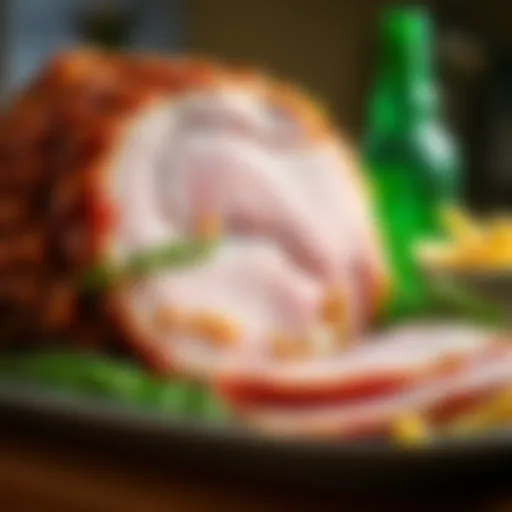Exploring Passover Main Courses and Their Significance
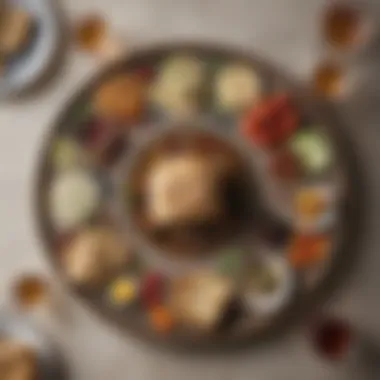

Intro
When Passover rolls around, kitchens across the world transform into hubs of activity. Families come together to observe a tradition enriched with history and flavor. This special holiday, which commemorates the Israelites' liberation from Egyptian bondage, centers around a meal referred to as the Seder. In this context, main courses take on more than just filling plates. They serve as culinary vessels that uphold cultural significance and represent heritage.
Each dish tells a story, weaving together threads of tradition and innovation. From braised briskets to vegan interpretations, the options are as diverse as the families that gather around the table. This article aims to explore the intricate dance of Passover main courses, diving into classic recipes, essential ingredients, and the evolving traditions that keep these meals alive.
Through the lens of culinary exploration, we’ll uncover how to strike a balance between respecting the age-old practices and adapting to modern dietary preferences. Join us as we navigate through the heart of Passover cooking, where the spirit of tradition meets culinary creativity.
Understanding Passover
To truly appreciate the main courses that grace the Passover table, one must first embark on a journey through the rich tapestry of this significant holiday. Understanding Passover is not merely about knowing the recipe for matzah ball soup or brisket; it's about grasping the essence of a celebration deeply rooted in history, culture, and spirituality. This section lays the foundation for the culinary exploration that follows by highlighting the holiday's historical context and cultural significance of food in Jewish tradition.
Historical Context
Passover, or Pesach as it’s known in Hebrew, commemorates the Exodus from Egypt, a pivotal event in Jewish history. This narrative is steeply enshrined in the Torah, specifically in the Book of Exodus, which recounts how the Israelites were freed from slavery. This escape from bondage is symbolized not only through the retelling of the story during the Seder but also in the foods that are consumed.
Every element on the Seder plate tells a tale. For instance, the bitter herbs (maror) represents the hardship of slavery, while the charoset, a sweet mixture of nuts and apples, symbolizes the mortar that the Israelites used in their labor. Understanding this historical context enriches our culinary endeavor, as cooking for Passover is laden with memories and shared narratives.
Cultural Significance of Food
Food during Passover serves a purpose beyond mere sustenance; it's a vehicle for cultivating and reinforcing communal bonds. Family and friends gather around the table, sharing dishes that have been passed down through generations. This communal aspect of dining is a cornerstone of the holiday.
Food becomes a language that speaks to heritage, tradition, and identity. Adhering to kosher for Passover guidelines doesn’t just affect what is eaten, but reflects a commitment to religious observance. The flavors and textures found in traditional dishes evoke nostalgia among those who partake in the meal, creating a tapestry of experiences that bind individuals to their ancestors and their shared culture.
"Food is not just what we eat; it is the stories we tell and the connections we forge through our shared experiences. The Passover meal encapsulates this notion beautifully."
The importance of understanding Passover, then, is not just about the how-to of cooking but about appreciating the why behind it all. With this foundation, we move forward to examine the key ingredients that serve as the building blocks for these soulful meals.
Key Ingredients for Passover Main Courses
When it comes to crafting an unforgettable main course for Passover, the ingredients hold paramount importance. They not only determine the flavor and texture of dishes but also carry deep historical and cultural resonance. The food assembled during this significant holiday often reflects centuries of tradition, where each ingredient is chosen with care. By understanding the key elements, one can delve into dishes that are not just satisfying to the palate but also rich in meaning.
Matzah and Its Variants
Matzah is perhaps the most iconic ingredient observed during Passover. This unleavened bread symbolizes the haste in which the Israelites fled Egypt, leaving no time for their bread to rise. Traditionally, matzah is made from just flour and water, baked within a strict timeframe. Variants include whole wheat matzah and flavored ones, like garlic and onion, which adds a twist to the otherwise plain flavor. Incorporating matzah into main courses, be it matzah ball soup or matzah crusted chicken, opens doors to creativity while honoring the holiday’s traditions.
Meats: Traditional Choices
Lamb
Lamb is not only a traditional choice for Passover but also carries a significant symbolic weight. It serves as a reminder of the paschal lamb sacrificed before the Exodus. When prepared right, lamb has a rich and tender flavor that transcends typical meat dishes. Grilled or slow-roasted, it often absorbs the herbs and spices it's paired with, bringing complexity to the table. However, its specific preparation requires attention to detail, as overcooking can lead to a gamey taste that’s less appealing. Despite this, its place on the Passover table is well-deserved, especially for those seeking to evoke deep-rooted cultural connections.
Beef
Beef brisket, another staple, is often the centerpiece of Passover feasts. This cut of meat is celebrated for its ability to absorb flavors during slow cooking, resulting in a melt-in-your-mouth experience. Commonly braised with aromatic vegetables and spices, its texture becomes tender over hours of cooking. One advantage of beef brisket is its versatility; it can be served warm or cold, making it suitable for various settings ranging from family gatherings to potluck dinners. However, it’s important to allow ample cooking time to achieve the desired result.
Chicken
Chicken is used for many who prefer a lighter meat option during Passover. It’s accessible and can be utilized in various recipes - from roasted whole chicken glazed with herbs to chicken stock for matzah ball soup. What’s appealing about chicken is its adaptability; it can easily take on flavors from different spices and marinades. However, customers must consider its cooking time carefully, as undercooked chicken poses health risks, while overcooking it can lead to dryness.
Vegetables and Sides
Root Vegetables
Root vegetables are essential in providing hearty, comforting sides for Passover meals. Carrots, potatoes, and sweet potatoes can be roasted to bring out their natural sweetness, forming a delightful contrast to the richer meats. Their creamy textures and ability to absorb flavors from herbs further enhance dishes. This makes them a fantastic choice for adding vibrancy and nutritional value to the meal. The downside might be the preparation time, as some require peeling and chopping.
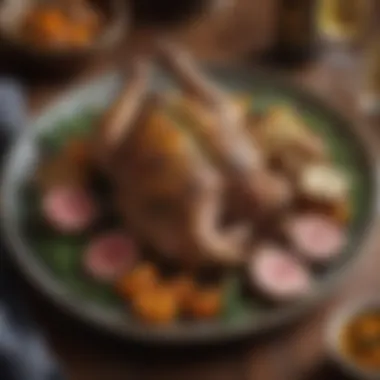

Leafy Greens
Leafy greens, like spinach and kale, add color and freshness to Passover tables. Often sautéed or steamed, they provide a refreshing counterpart to heavier dishes. Their nutritional value should not be overlooked; they are packed with vitamins and minerals, making them health-conscious options. While their flavors are milder, they can absorb the essence of spices they are cooked with. The main consideration here is ensuring they are not over-or under-cooked, as the texture plays a crucial role in overall enjoyment.
Herbs and Spices
Herbs and spices can transform a simple dish into an exceptional one, showcasing creativity in the kitchen. Fresh dill, parsley, or thyme not only enhance flavors but also add aroma. They can be used as finishing touches or incorporated during cooking to elevate meat dishes. Experimenting with spice blends like za'atar or harissa can bring exciting flavors to traditional recipes. However, moderation in use is vital; excess amounts can overshadow the dish.
"The beauty of Passover meals lies in their ability to honor tradition while allowing for personal interpretation."
In summary, the key ingredients for Passover main courses reflect a balance between tradition and culinary innovation. Whether one is whipping up a robust brisket, a flavorful lamb, or a comforting chicken dish, understanding these elements paves the way for a memorable Passover gathering.
Classic Passover Main Courses
When we dive into the realm of Passover main courses, we step into a culinary treasure chest filled with flavors steeped in history. These dishes not only offer a taste of tradition but also serve as a bridge connecting generations and cultures. Classic Passover main courses are often the crown jewels of the Seder table, showcasing age-old recipes and techniques that have been cherished over the years. Their significance lies not just in their flavors, but in their ability to evoke memories, spark conversations, and bring families together.
Rosh Hashanah Influence
The intertwining of Rosh Hashanah traditions with those of Passover creates a unique culinary narrative. Dishes often meld together lessons of renewal and reflection. Many families take inspiration from Rosh Hashanah's symbolism, especially its emphasis on sweetness and abundance. Fo example, honey-glazed items can transition to savory dishes during Passover, reminding those at the table of hopes for prosperity in the year ahead. It’s common to see dishes like honey-roasted root vegetables appearing on Passover tables as a nod to this connection. Such adaptations honor the past while elevating the present experience of the meal.
Slow-Roasted Lamb Shank
The slow-roasted lamb shank stands tall among the traditional offerings, embodying a sense of comfort and festivity that resonates deeply during Passover. It’s not just a dish; it's a ritual in itself. Preparing a lamb shank requires patience; the meat is marinated and cooked low and slow, allowing the flavors to develop fully, while the tendons break down into tender morsels.
Often, herbs like rosemary and garlic are paired with citrus to create a savory yet slightly tangy profile.
"A well-prepared lamb shank is more than just a meal; it's a memory crafted over time."
To serve it, the shank is typically presented on a platter, bathed in its own rich juices, accompanied by the side dishes that add contrast and color. Think of deep, roasted vegetables or a vibrant matzah ball soup to balance the plate. This main course isn’t merely about sustenance; it's an experience meant to engage each sense.
Beef Brisket Preparation Techniques
Beef brisket is revered in many households, and its preparation can often become a family tradition, passed down through generations. The ways to prepare brisket are numerous, but some secrets can elevate this otherwise humble cut of meat.
First and foremost, marinating is crucial. Consider a blend of spices that includes paprika, garlic powder, and perhaps a touch of brown sugar for sweetness. This not only flavors the meat but also aids in tenderizing it as it sits.
Once marinated, the cooking process can take various paths:
- Cooking methods include braising, where brisket is cooked slowly in a covered dish, often submerged in broth, red wine, or a mix of both.
- Smoking brings a complex depth of flavor, integrating a subtle smokiness that dances on the palate.
- Slow cooking in a crockpot can also produce tender outcomes, especially for those managing busy schedules.
In every technique, the key is cooking low and slow, ensuring that the brisket becomes fork-tender, inviting diners to savor every bite. The beauty of brisket is how it melds flavors during the cooking time, making it a centerpiece that truly holds the holiday spirit.
As we explore these classic main courses, it’s evident that the act of cooking during Passover is infused with love, history, and community. These dishes weave together the threads of past and present, allowing everyone at the table to partake in a feast that is as much about tradition as it is about flavor.
Innovative Takes on Traditional Dishes
In an ever-evolving culinary landscape, innovative takes on traditional dishes present a unique opportunity to honor the past while updating recipes for contemporary tastes. The significance of redefining these age-old meals lies not just in creativity, but also in accessibility; adapting traditional recipes allows for a wider range of ingredients and techniques, making them suitable for various dietary preferences, including vegetarianism and veganism. As families gather for Passover, merging classic elements with fresh ideas can breathe new life into the table, ensuring a memorable and inclusive experience for everyone.
Fusion Cuisine Adaptations
When it comes to adapting traditional Passover fare, fusion cuisine proves to be an excellent avenue. This approach fuses cooking methods and ingredients from various cultures, broadening the scope of what's possible at the Passover table. For instance, one might consider a Moroccan-inspired brisket, spiced with traditional harissa, or a quinoa-stuffed matzah kugel that incorporates South American flavors.
Not only does fusion cuisine delight the palate, but it also opens the door to creativity, engaging diners in a culinary conversation that traverses different cultural landscapes. This blending of flavors can evoke memories and stories, enhancing the communal experience of the holiday. Additionally, adapting these classic dishes enables cooks to incorporate local, seasonal ingredients, which can vary significantly from one year to the next, supporting sustainability efforts.
Vegetarian and Vegan Options
As dietary preferences evolve, vegetarian and vegan options have become essential in modern Passover meals. Not only do these options cater to a broader audience, but they also emphasize healthful and creative eating.
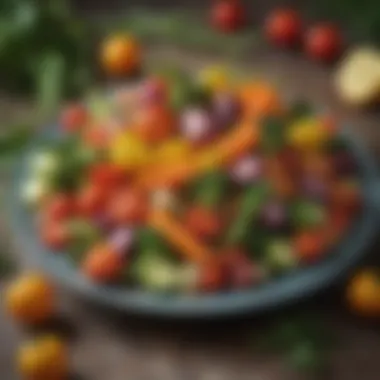

Stuffed Peppers
Stuffed peppers have found a special place in the realm of innovative Passover dishes. This dish is particularly notable for its versatility; you can stuff bell peppers with a variety of fillings, from seasoned rice and beans to herby quinoa mixtures. The vibrant colors of the peppers add visual appeal and a fresh touch that can sometimes be absent in traditional meals.
The key characteristic of stuffed peppers is their ability to be customized to individual preferences, whether one leans towards heartier meals or lighter fare. Many find this aspect appealing when preparing a holiday meal, where accommodating different tastes can often be a challenge. An advantage of stuffed peppers is also their ability to be made ahead of time. They can be prepped early in the day and popped in the oven just before serving, easing the stress of meal preparation.
Quinoa Pilaf
Quinoa pilaf offers another exciting alternative, substituting traditional grain dishes often served during Passover. The unique feature of quinoa is its complete protein profile, making it a nutritious choice for vegans and vegetarians. It stands out among grains due to its earthy flavor and slight crunch, making it a compelling option for those looking to elevate their side dishes.
In terms of ease of preparation, quinoa pilaf can be swiftly cooked and flavored with a myriad of ingredients—dried fruits, nuts, and spices—tailoring the dish to the flavors of the holiday while also adding depth and interest. However, it’s essential to rinse quinoa well before cooking to remove its natural bitterness—a step that sometimes gets overlooked but drastically affects the final outcome.
As Passover meals continue to evolve to satisfy diverse palates and dietary needs, incorporating innovative takes allows hosts to honor tradition while welcoming new ideas into their kitchens. In doing so, they create opportunities for meaningful conversations around food, culture, and shared experiences.
Preparation and Cooking Techniques
Understanding the correct preparation and cooking techniques is crucial when tackling Passover main courses. These methods not only enhance flavor and tenderness but also allow for the creative expression of culinary traditions. The key here lies in how each technique brings out the best in carefully selected ingredients while respecting the historical and cultural context of the meal. A well-executed technique can transform an ordinary dish into something extraordinary, and it's all about making the most out of that culinary canvas.
Marinating: A Key Step
Marinating plays an essential role in the preparation of many traditional Passover dishes, especially those featuring meats. The process of soaking meat in a blend of acidic and flavorful ingredients—like vinegar, wine, herbs, and spices—helps to tenderize the protein while infusing it with depth and richness. One might say it gives the dish a little extra umph it needs. For example, a rosemary-garlic marinade can bring out the natural flavors of lamb, which is a star player during Passover feasts.
Consider these important benefits of marinating:
- Flavor Enhancement: A good marinade will seep deep into the meat, rather than just sitting on the surface, creating a harmonious blend of tastes.
- Tenderization: The acidic components help break down tough fibers in the meat, leading to a more succulent result.
- Time Consideration: A little forward planning can work wonders, as marinated meats can sit overnight, allowing flavors to meld together.
To illustrate the process, here's a simple marination recipe:
Such handling can elevate your centerpiece dish, making it a memorable part of the festive gathering.
Slow Cooking vs. Roasting
Deciding between slow cooking and roasting often depends on the desired outcome and the specific dish you intend to prepare. Both techniques have their merits and can yield fantastic results, but they serve different purposes in the kitchen arsenal.
Slow cooking, often using a crock pot or slow cooker, allows for an extended cooking period at a low temperature. This method is particularly effective for tougher cuts of meat, like brisket. The long cooking time gives the meat a chance to become tender and absorb flavors from any vegetables or broth accompanying it. The process is nearly set-it-and-forget-it, letting busy hosts focus on other aspects of meal preparation.
However, roasting leans toward a more traditional approach, often used for items that benefit from a crispy exterior while keeping a juicy interior. Roasting a lamb shank or a whole chicken not only enhances flavor through caramelization but also creates an appealing presentation that can almost steal the show before the meal even begins.
Here are a few considerations for each method:
- Slow Cooking:
- Roasting:
- Pros: Tenderizes meat gradually, less active cooking time, great for hearty stews.
- Cons: Takes longer, may not achieve a crispy finish.
- Pros: Ideal for presentation, achieves crispy skin, shorter cooking time for tender cuts.
- Cons: Requires more attention to avoid overcooking.
Remember, both methods can yield spectacular results when executed well, so choosing one involves understanding what you want to convey through your Passover meal.
Ultimately, mastering these techniques is about artistry and tradition, allowing for a narrative that connects the past with the present. This is what culminates into a truly memorable Passover main course.
Serving Suggestions and Presentation
Serving suggestions and presentation play a vital role in the overall experience of any meal, and the same holds true for Passover main courses. When it comes to this festive holiday, the food is not just about sustenance; it's also about honoring tradition, creating an ambiance, and enhancing the joy of gathering with loved ones. How food is served can significantly affect how diners perceive and appreciate each dish, making it essential to consider these aspects thoroughly.
A thoughtfully presented dish can tantalize the senses even before the first bite is taken. Colors, textures, and arrangements are the dance partners in culinary presentation, enticing diners to engage more passionately with the meal. By focusing on presentation, you not only elevate the dining experience but also pay homage to the beauty of the ingredients and the culture surrounding the celebration of Passover.
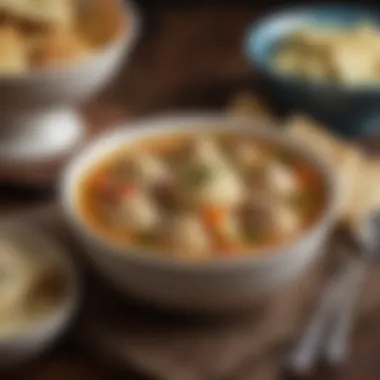

Grabbing attention with style is important. The first impression can often make or break the anticipation. This is where simple but effective techniques can make a world of difference.
"Food is a memory, a ritual, and an expression of love—and its presentation should reflect that."
Appropriate Accouterments
The right accouterments can enhance the flavors of your main course while adding a layer of visual appeal. For Passover meals, this may include everything from traditional condiments to more innovative additions. Here are some ideas:
- Charoset: This sweet mixture, made from apples, nuts, wine, and spices, not only serves as a reminder of the mortar used by the Israelites in Egypt but also pairs beautifully with roasted meats.
- Horseradish: Often used as a condiment, a dollop of horseradish can add a kick that complements the richness of roasted lamb or beef brisket.
- Dipping Sauces: Whether it's a yogurt-based sauce or a spicy harissa, having a few options at the table allows guests to personalize their experience, making it interactive.
Additionally, using fresh herbs like parsley or dill as garnish can brighten up the plate and give it a fresh feel, embodying the spirit of spring, which is especially significant during Passover.
Plating Techniques for Aesthetic Appeal
Plating isn’t merely about putting food on a dish; it’s an art form that combines creativity and technique. Here are several plating techniques that can elevate your Passover main courses:
- Layering: Create height by layering different components of the dish. For instance, consider layering a slice of beef brisket over a bed of mashed root vegetables, using the vibrant side to complement the color of the meat.
- Sauce Trails: Instead of a puddle, create a trail of sauce on the plate. This not only looks elegant but also draws the eye across the composition, making it more visually inviting.
- Negative Space: Allow some areas of the plate to remain empty. This technique prevents the dish from appearing overcrowded, letting the food breathe and shine in its own right.
- Use of Color: Involve colorful ingredients on the dish – be it through various vegetables or garnishes. The vivid colors will not only grab attention but will also potentially highlight the freshness and quality of your ingredients.
By applying these techniques, you create not just a meal but a celebration of all the senses. It’s not just about the food on the table; it’s also about the stories and connections built around it. This festive time deserves a presentation that reflects the significance of the occasion, wrapping every dish in a love for family and tradition.
Pairing Drinks with Passover Main Courses
Pairing drinks with Passover main courses is more than just a side note; it's an intricate part of the dining experience. Beverage choices not only elevate the meal but also adhere to tradition, bringing an added layer of meaning. The right drink can enhance the flavors of the dish and set the tone for the entire gathering, making each bite and sip an occasion worth cherishing.
When you think about it, the right drink can turn a simple dish into something extraordinary. For instance, serving a robust wine with slow-roasted lamb can highlight the earthy notes of the meat, while a crisp white wine can offer a refreshing contrast to richer recipes, like beef brisket. This blend of flavors can impress everyone's palate and create harmony on the table.
Another consideration is also about balancing the traditions of the Jewish calendar with modern tastes. Many Passover observances come with restrictions, making the selection process both an art and a thoughtful endeavor.
Types of Wine for Passover
Selecting wines suitable for Passover involves navigating various aspects: kosher status, flavor profiles, and pairing capacity. Kosher wines must meet specific criteria, ensuring they are free from any non-kosher additives—from grapes to fermentation processes. Most importantly, they should hold up well against the rich, often savory flavors of Passover dishes.
Some popular types of wine which are often seen during Passover include:
- Cabernet Sauvignon: This full-bodied red wine pairs wonderfully with robust meats like brisket.
- Chardonnay: A go-to white option that complements lighter dishes or even fish, common choices during the Seder.
- Malbec: Known for its fruitiness, it can smooth out the edges of spiced dishes.
- Rosé: An refreshing alternative, especially great for those warm Passover days.
A few specific brands like Manischewitz or Baron Herzog often come to mind when discussing kosher wines. These selections can vary greatly in flavor, but they all aim to respect the traditions associated with the holiday while still providing a quality drinking experience.
Non-Alcoholic Alternatives
While wine takes center stage, non-alcoholic alternatives shouldn't take a back seat. These options can be just as impressive and are often appreciated, especially by guests who prefer not to partake in alcohol.
When crafting a drink menu for Passover, consider the following non-alcoholic beverages:
- Sparkling grape juice: A festive choice that mimics the celebratory feel of wine without the alcohol.
- Flavor-infused water: Adding herbs like mint or slices of citrus not only enhances the taste but also presents beautifully in a glass jar.
- Herbal teas: Rich in flavor and highly aromatic, these can offer warmth for those chilly evenings.
- Non-alcoholic cocktails: Craft a mix of juices with herbs to create a stunning presentation; think pomegranate juice mixed with lime and garnished with fresh mint.
A thoughtful drink selection can also serve as a conversation starter. Presentation is key, and serving these non-alcoholic options in elegant glassware can ensure they don’t feel like an afterthought.
"Every meal is a journey, and drinks pave the road with tastes and aromas that linger long after the last bite."
Finale and Reflections
As we wrap up our culinary journey through Passover, it becomes evident that the significance of these meals extends far beyond mere sustenance. Each dish tells a story rooted in history and culture, acting as a bridge connecting generations. One cannot overlook the emotional power tied to these particular meals, especially when shared among family and friends. It’s not just about the food; it's about the memories and traditions that come with it.
Reflecting on the ongoing evolution of Passover meals reveals that innovation and tradition can coexist harmoniously. New ideas and flavors can elevate classic recipes while still paying homage to their origins. As culinary boundaries expand, integrating global culinary influences allows for a richer dining experience. Such adaptations enrich the meal while ensuring the essence of Passover remains intact.
Notably, it’s crucial for those preparing these meals to embrace flexibility and creativity in their culinary approaches. Encouraging personal adaptations based on family preferences, dietary needs, or even just whims can enhance the communal aspect of Passover. Personal touches transform dishes and breathe life into traditional recipes, making them a true reflection of the individual or family preparing them.
Ultimately, each meal can become a canvas for creativity, guided by the sensitivity to tradition. This balance brings depth not only to the meal but also to the relationships fostered around the table.
"Passover is not simply a feast, it's a tapestry woven with heritage, and each thread tells a story of resilience."
The evolution of Passover meals encourages a dialogue between innovators and traditionalists. As you gather around the table this season, think about how you can merge old with new. Are there local ingredients you can use? Perhaps a twist on an age-old recipe? Embracing this spirit of exploration in your own kitchen can lead to delightful discoveries. Indeed, the heart of Passover meals thrives on the connections we forge and the flavors we share.





